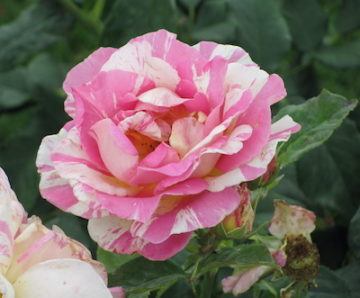by Mary Hrovat
 A rose is a rose is…well, you know. Botanically, a rose is the flower of a plant in the genus Rosa in the family Rosaceae. But roses carry the weight of so much symbolism that a rose is seldom only a rose.
A rose is a rose is…well, you know. Botanically, a rose is the flower of a plant in the genus Rosa in the family Rosaceae. But roses carry the weight of so much symbolism that a rose is seldom only a rose.
Their symbolic luster is so intense that it casts an alluring light not only on the word rose itself but also on many of the phrases that contain it. A song called “The Last Zinnia of Summer” could never be as melancholy as “The Last Rose of Summer,” no matter how much you like zinnias. When I was a child and a teenager, I read a lot of things that I only half-understood. One of these was the phrase attar of roses, which had a mysterious and lovely sound to me. I eventually learned that it’s an essential oil made using damask roses—a beautiful common name for Rosa damascene. I had a vague impression of damask as a luxurious silky or satiny fabric, so I thought damask roses must have especially soft satiny petals, but in fact the species name was given to them because they were thought by some to be native to Damascus. The fabric is also named for Damascus, which was once an important producer and trade center for damasks.
There’s also a glow in my mind around concepts that are less directly related to roses. Rose gold is an alloy of gold with copper and perhaps silver; the phrase is especially luminous to me and reminds me of sunrise. Ashes of roses—another term I ran across in my early reading, and one that delights me still—describes a soft dusty pink color.
Maps are magical enough on their own, but the compass rose, the many-pointed figure set within a circle that’s used to indicate directions, adds a little extra glamor. There’s something called a rose engine lathe, which is used to etch very fine curvilinear patterns resembling roses or other flowers, or symmetric geometric patterns with multiple lobes. At this point in my mental lexicon, the rosy glow starts to fade, and it disappears entirely when I contemplate the rose ear, a type of ear some dogs have that folds backward, revealing part of the inside. Even the word rose can’t do much to make a dog’s ear alluring.
∞
Roses are such storied flowers in part because of their beauty and sweet scent. Perhaps they’re most commonly associated with love. The red rose is most typically identified as the flower of romantic love, and roses of other colors are seen as representing other types of love and affection. In classical mythology, the rose was the flower of Aphrodite, the beautiful goddess of romantic love, desire, and fertility.
There are many stories about Aphrodite and roses. According to one myth, she fell in love with a mortal, Adonis, who ignored the advice she had given him about hunting and as a result was killed by a bear. Supposedly all roses were white until some were reddened by the blood of Aphrodite, who cut her feet rushing barefoot to try to save him. Alternatively, a jealous goddess created the red rose in an attempt to make something with a beauty to rival Aphrodite’s. These days roses are big business and are relentlessly pushed upon us at Valentine’s Day, but the sweetness of the association with love of all types continues more or less untarnished.
The rose has a different set of meanings in Christian belief, and in particular to Catholics. There’s a story that in the Garden of Eden, roses had no thorns, and thorny roses appeared as one of the consequences of the Fall. The Virgin Mary is described as a thornless rose because she was conceived without original sin. The Catholic litany of the Blessed Virgin calls on Mary as mother most pure, mother inviolate, and mother undefiled (profoundly troubling epithets, when you think about it). Some stories claim that white roses were turned red by the blood of Christ.
The medieval Christmas carol “There Is No Rose of Such Virtue” refers to the Blessed Virgin as a rose. The definition of virtue in terms of moral qualities (in this case, the context suggests specifically chastity and purity) may be only part of the intended meaning. According to an obsolete definition, virtue can also refer to healing strength, in particular the medicinal power of a plant. And indeed healing powers have been ascribed to roses, in particular to rose hips from the dog rose, Rosa canina. In the carol “Lo, How a Rose E’er Blooming,” the rose represents the virgin’s divine son.
∞
Roses are also political symbols. The Wars of the Roses in 15th-century England were named for the symbols of the warring families: the red rose of the Lancasters and the white rose of the Yorks. When Henry VII married Elizabeth of York, the families were united, and the Tudor rose, which is still used as a floral emblem of England, combines the red and white roses. For such a short-lived dynasty, the Tudors cast a long shadow.
More recently, the red rose became a socialist symbol in the aftermath of two important events in American labor history. After the Haymarket Affair in Chicago in 1886, which was associated with a strike at the McCormick Harvesting Machine Company, socialist sympathizers wore red roses or carnations in support of the eight men who were unfairly accused of inciting riots (four of them were hanged in 1887, and another committed suicide; they are honored today by the Haymarket Martyrs’ Monument).
In 1911, Edward Oppenheim published a poem called “Bread and Roses,” which was later set to music, and the song became associated with the 1912 textile workers’ strike in Lawrence, Massachusetts, and in particular with women workers. This strike was one of the great efforts of working people in the 20th century; it’s also called the Bread and Roses strike. Together, these two events solidified the red rose as a symbol of socialism.
In the song, roses symbolize the things that humans need beyond mere survival: “Hearts starve as well as bodies,” run the lyrics, and “Yes, it is bread we fight for, but we fight for roses too.” The short, resonant phrase “bread and roses” sums up a demand for a decent life and also for “art and love and beauty,” for the meeting of all basic human needs. The song remains a powerful anthem.
∞
I remember my parents’ religion primarily as strict and punitive. However, there were notes of kindness and mercy in their beliefs; many of these were associated with the Blessed Virgin, who was seen as an intercessor, a heavenly mother who would convey our prayers to God and plead for mercy on our behalf. The Litany of the Blessed Virgin begins “We fly to thy patronage, oh holy Mother of God” and, in addition to lauding her purity, it also addresses her as Virgin most merciful, health of the sick, comforter of the afflicted, and mystical rose (a name she was given by Bernard of Clairvaux).
Some of the lives of the saints include stories about roses. For example, according to a story I learned as a child, St. Elizabeth of Hungary secretly brought food to the poor against the wishes of her husband. When he caught her going out with bread hidden under her cloak, he demanded that she reveal what she was carrying, expecting to catch her disobeying his wishes. When she opened her cloak, the bread had been miraculously changed to roses. Similar stories are told of several other holy people in different circumstances.
 The rose story I’m most familiar with is that of St. Thérèse of the Child Jesus, also known as Thérèse of Lisieux and The Little Flower. She was born in 1873 and became a cloistered Carmelite nun at the unusually young age of 15. She died at 24 of tuberculosis. Her unheroic everyday approach to sanctity by acts of kindness and love for those around her, which she called the little way, became popular with the Catholic laity, and in particular with my mother. Mom read everything she could find about this saint and her parents, Louis Martin and Zélie Guérin Martin (who were canonized in 2004, too late for my mother to know about it).
The rose story I’m most familiar with is that of St. Thérèse of the Child Jesus, also known as Thérèse of Lisieux and The Little Flower. She was born in 1873 and became a cloistered Carmelite nun at the unusually young age of 15. She died at 24 of tuberculosis. Her unheroic everyday approach to sanctity by acts of kindness and love for those around her, which she called the little way, became popular with the Catholic laity, and in particular with my mother. Mom read everything she could find about this saint and her parents, Louis Martin and Zélie Guérin Martin (who were canonized in 2004, too late for my mother to know about it).
Shortly before St. Thérèse died, she wrote “After my death, I will let fall a shower of roses. I will spend my heaven doing good upon earth.” Mom set great store by the belief that St. Thérèse would show that she had heard your prayer by sending you a rose. Mom interpreted this fairly generously. Once when she was praying that my father would find a new job after being laid off in the recession of the 1980s, she was buoyed to wake up one morning to hear the song “Second-Hand Rose” playing on the clock radio.
A Catholic website I found says, rather reprovingly, that what the saint is sending is grace and a rose, and the grace is the important thing. But I wonder if my mother might have found the grace and the rose to be essentially the same thing. She surely prayed enough unanswered prayers that she didn’t expect to receive everything she asked for. My impression is that she wanted a sign that the saint had listened to her.
∞
In “Reflections on The Name of the Rose,” Umberto Eco wrote that “the rose is a symbolic figure so rich in meaning that by now it hardly has any meaning left.” I would put it that the rose has a multitude of symbolic meanings that cannot be completely captured in a net of words. Perhaps each person has a unique set of meanings that make up the gestalt of the rose, although of course there’s considerable overlap among the meanings assigned by people of the same time and place.
 A key part of my own rose gestalt involves my mother and my sister. For one thing, we all loved the scent of roses. In addition, my mother’s devotion to St. Thérèse, as well as our love for each other, grew into a view of roses in terms of grace and kindness. Even though I left the Church decades ago, these connotations are still there for me, in part because of what roses meant to us personally. For years each of us would tuck small luxuries into the boxes of Christmas and birthday presents we mailed to each other—rose-scented soap, candles, lotion, bath oil, things we would have been reluctant to spend money on for ourselves, things each of us thought we probably didn’t deserve. But each of us thought the others deserved them. I think the message behind these gifts was, “I cherish you.” My mother and my sister are both gone now, but these little gifts of sweetness that we gave each other will always be part of what roses symbolize to me. And, to paraphrase Thomas Moore, the scent of roses will always hang round my memories of them.
A key part of my own rose gestalt involves my mother and my sister. For one thing, we all loved the scent of roses. In addition, my mother’s devotion to St. Thérèse, as well as our love for each other, grew into a view of roses in terms of grace and kindness. Even though I left the Church decades ago, these connotations are still there for me, in part because of what roses meant to us personally. For years each of us would tuck small luxuries into the boxes of Christmas and birthday presents we mailed to each other—rose-scented soap, candles, lotion, bath oil, things we would have been reluctant to spend money on for ourselves, things each of us thought we probably didn’t deserve. But each of us thought the others deserved them. I think the message behind these gifts was, “I cherish you.” My mother and my sister are both gone now, but these little gifts of sweetness that we gave each other will always be part of what roses symbolize to me. And, to paraphrase Thomas Moore, the scent of roses will always hang round my memories of them.
∞
The photographs are mine. The roses were photographed in the Parc de Bagatelle, Bois de Boulogne, Paris. The statue of St. Thérèse of Lisieux was photographed in the Basilica of Sainte Clotilde, Paris.
∞
You can see more of my work at MaryHrovat.com.
